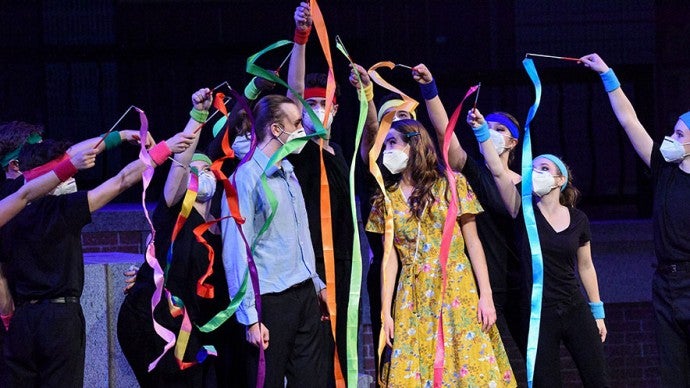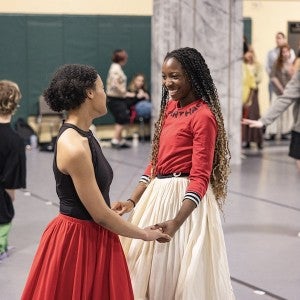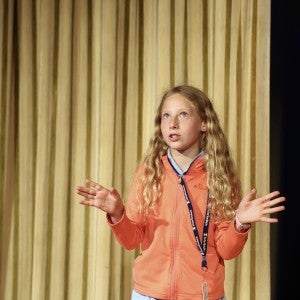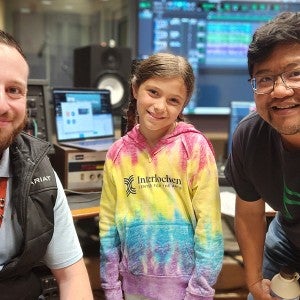Interlochen Online's next session begins May 6—enroll in any course or certificate program now.
What can still be taught during COVID-19: Bodies, voices, dramaturgy
In a column for American Theatre, Director of Theatre Bill Church finds silver linings to teaching theatre in the time of COVID-19.

Arts Academy theatre students present a scene from The Noteworthy Life of Howard Barnes.
This column by William Church, director of theatre at Interlochen Center for the Arts, first appeared in American Theatre.
“No social distancing orders will stop us from creating and sharing our work!” exclaimed Charlotte Kearns, one of my theatre students at Interlochen Arts Academy, as part of her introduction to the Arts Academy’s May 2020 production of William Shakespeare’s As You Like It, a staged performance that morphed into an audio drama soon after students were sent home due to the Covid-19 pandemic.
Looking back, Charlotte’s fierce determination amid the seismic start to the pandemic captures the spirit of all the theatre students I’ve worked with since then, both virtually and in person. While none of us would have wished for this extended intermission from live, communal theatre, the restrictions of the era have pushed each of us—students and teachers alike—to expand our creative capacities in new ways, many of which would have been inconceivable before. Ultimately, those of us lucky enough to teach theatre during COVID-19 can seize this moment to renew our focus on training, readying students to explode into the field of live performance like never before.
Last spring and summer, when Interlochen Arts Academy and Arts Camp students took part in exclusively virtual theatre programs, we discovered that we had time for deep dives into character analysis and dramaturgical studies—projects that occasionally get shortchanged under usual circumstances. Last spring, for example, under the direction of Andrew McGinn, the director of the Arts Academy’s production of As You Like It, students created not just an audio version of the play with an original soundtrack, but also a website featuring a dramaturgical presentation. Actors worked as their own dramaturgs to present images, essays, and videos designed to help the audience, and themselves, to better understand the world of the play.
We also discovered that time spent on Zoom—company-wide acting warmups, small-group scene work classes, self-taped monologues, and live Q&As with guest artists—functioned as a sort of acting-for-the-camera class. At a time when most auditions are conducted by self-tape, our students trained every day to adjust their expression and energy for the camera. As a result, they gained valuable on-camera experience and techniques that should serve them well as they enter the profession.
Similarly, for musical theatre students, technology that might not have been considered before the pandemic has enabled nuanced improvements in technique. With virtual private lessons, for example, my colleagues can see students’ mouths and jaws close up on their screens, enabling them to give detailed instructions for subtle improvements that could have previously gone undetected.
In accordance with Interlochen’s rigorous health and safety protocols, we continued these virtual private lessons even after the Arts Academy resumed in-person instruction in August. All our students must also wear face coverings and stay six feet apart from one another—radical restrictions for any teenager, especially for young actors.
Yet in a matter of months, I’ve witnessed a powerful expansion of artistic range in my students. With half their faces covered up, and no physical contact with others, my academy students have discovered new ways to convey the emotional lives of their characters. Engaging their whole bodies to express emotion through movement is now second nature. With their mouths partially muted by masks, students have also enhanced their articulation by honing in on the ways their lips, teeth, and tongue work together to create sound. Since masks render any kind of sloppiness in diction incomprehensible, students have had to double down on the precision of their technique.
Limitations on the number of people allowed in indoor spaces has affected every aspect of our productions, from the size of our casts, staging, and costume changes to performance venues. Small casts mean that each student receives more attention, while the use of outdoor venues required them to adapt their playing styles to bigger spaces, and to the ambient sounds of nature. Meanwhile, costumes were designed not only to withstand cold Michigan weather, but to integrate face coverings as seamlessly as possible.
Perhaps most importantly, the pandemic has given us the space and time to reflect with students on vital issues of social justice in the professional theatre world. Small group settings offer the breathing room and intimacy to embark upon meaningful conversations about the canon of material we study and our casting protocols. How do we truly diversify the canon? How do we tell stories that are inclusive of all of our students? With much of the theatre world on hold, there is no better time than now to wrestle with questions like these.
Without a doubt, the past few months have been intense and exhausting for all of us. Yet our students are engaged and productive. A palpable sense of gratitude imbues our work. We know just how lucky we are to retreat to our “happy place” during a pandemic, when so many friends and colleagues in the theatre industry cannot.
When theatre without masks, distancing, or Zoom finally returns, the celebration, deep appreciation, and huge outpouring of energy towards passionate, important projects will be like nothing we’ve experienced. Young actors will be ready.





